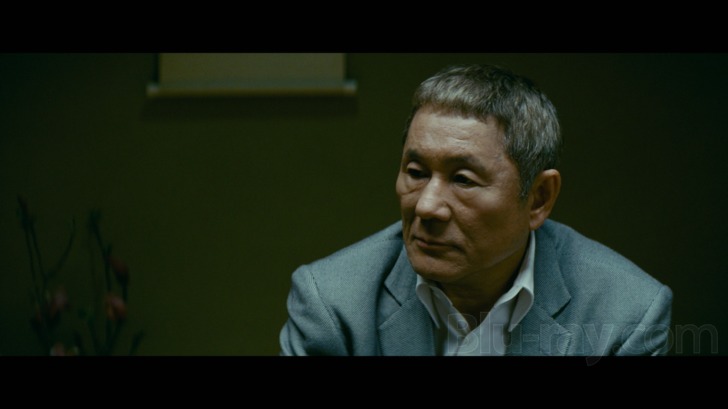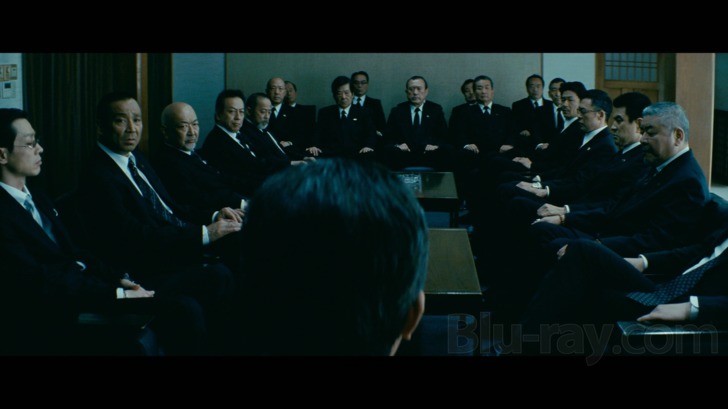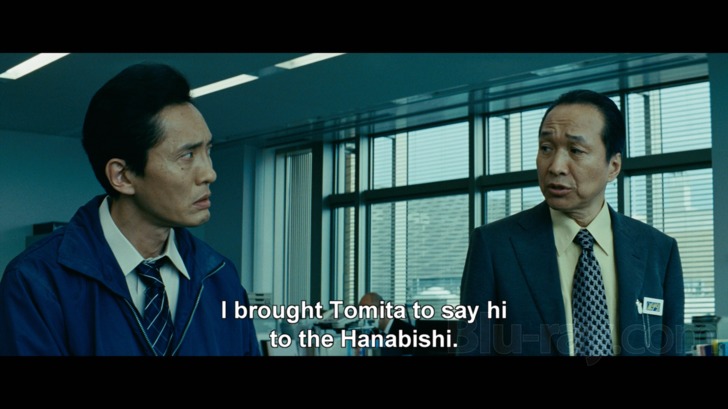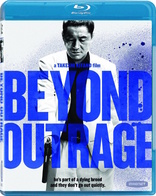Beyond Outrage Blu-ray Movie
HomeBeyond Outrage Blu-ray Movie 
アウトレイジ ビヨンド / Outrage BeyondMagnolia Pictures | 2012 | 112 min | Rated R | Mar 11, 2014
Movie rating
7.4 | / 10 |
Blu-ray rating
| Users | 4.5 | |
| Reviewer | 4.0 | |
| Overall | 4.0 |
Overview
Beyond Outrage (2012)
As the police launch a full-scale crackdown on organized crime, it ignites a national yakuza struggle between the Sanno of the East and Hanabishi of the West. What started as an internal strife in Outrage has now become a nationwide war in Outrage Beyond.
Starring: Takeshi Kitano, Ryô Kase, Toshiyuki Nishida, Shun Sugata, Machiko OnoDirector: Takeshi Kitano
| Foreign | Uncertain |
| Drama | Uncertain |
| Crime | Uncertain |
| Action | Uncertain |
Specifications
Video
Video codec: MPEG-4 AVC
Video resolution: 1080p
Aspect ratio: 2.40:1
Original aspect ratio: 2.39:1
Audio
Japanese: DTS-HD Master Audio 5.1 (48kHz, 24-bit)
Subtitles
English, English SDH, Spanish
Discs
25GB Blu-ray Disc
Single disc (1 BD)
BD-Live
Playback
Region A (locked)
Review
Rating summary
| Movie | 4.0 | |
| Video | 4.5 | |
| Audio | 4.0 | |
| Extras | 3.5 | |
| Overall | 4.0 |
Beyond Outrage Blu-ray Movie Review
Trust No One
Reviewed by Michael Reuben March 11, 2014Watching Beyond Outrage, the sequel to "Beat" Takeshi Kitano's 2010 return to the Japanese gangster genre in which he first rose to prominence, I was struck by an unexpected similarity: Kitano, who writes, directs, edits and stars, had plotted the film the same way Shakespeare plotted his major tragedies. Both artists share the same fascination with the intricacies of conspiracy, deception and double-dealing. Long, ominous buildups erupt in sudden bursts of violence, sometimes of Grand Guignol extremes (think of Gloucester's eyes being gouged out on stage in King Lear). The story ends unhappily with a pile of corpses. Admittedly, Kitano's yakuza speak in prose, not verse, and much of the prose in Beyond Outrage is profanely direct (assuming the English subtitles are accurate). But Kitano's poetry comes from his memorable visuals, where gangsters confer like corporate directors but with the weight of an ancient brotherhood's tradition to guide them (and sometimes mislead them). Beyond Outrage plays out in a secret world separate from and largely invisible to that of the average person. In that sense, it's like the world of Shakespeare's nobility: a class apart. The tragedy was only beginning in Outrage, and its full dimensions aren't yet visible by the end of Beyond Outrage, because the third part of the trilogy has yet to appear. However, Kitano has structured the individual stories so that this second part reaches a logical interim conclusion that provides both a resting place and a point of departure for his grand finale.

(Note: Certain major events of Outrage are referenced below. Those who wish to view the first film with no advance knowledge should skip this section.) Five years have passed since the events of Outrage. The new leader of eastern Japan's powerful Sanno crime syndicate, Kato (Tomokazu Miura), has consolidated has position, having assassinated and replaced his predecessor. With the help of his underboss, Ishihara (Ryo Kase), Kato has refashioned the Sanno into a numbers-driven meritocracy, where seniority no longer counts. This does not sit well with old-guard members like Tomita (Akira Nakao), who find themselves pushed aside. The Sanno's chief rival is the powerful Hanabishi clan, headquartered in Osaka and run by the wily chairman, Mr. Fuse (Shigeru Koyama). With the help of two underbosses, Nishino (Toshiyuki Nishida), the diplomat, and Nakata (Sansei Shiomi), the brute, Mr. Fuse alternately poses as Kato's enemy and his ally. In the end, of course, his only interest is what's good for the Hanabishi. The additional player that Kitano adds in Beyond Outrage is the police force in the person of Det. Kataoka (Fumiyo Kohinata), a Machiavellian operator whose methods and motives are always in question, especially to his straight-arrow partner, Det. Shigeta (Yutaka Matsushige, who is notable for his 6' 6" height). Alternately posing as a facilitator, a corrupt cop, a master manipulator inspiring the gangs to destroy each other and a career strategist climbing the ranks of the Metropolitan Police, Kataoka wears his self-effacing smile like a mask. He is everybody's friend, and nobody's. It is Det. Kataoka who arranges for the early release of Otomo (Kitano, listed under his actor's monicker of "Beat Takeshi") from the maximum security prison where we left him at the end of Outrage. A former enforcer for the Sanno, Otomo is now fully recovered from the stab wounds inflicted on him by Kimura (Hideo Nakano), a member of a rival gang crushed by the Sanno in the first film, who attacked Otomo in retaliation for the facial scarring that Kimura received at Otomo's hands. The scheming detective wants to broker a peace between Kimura and Otomo so that he can use them as a force to destabilize the Sanno, but Otomo has had enough of the yakuza life. He seeks a position, preferably abroad, in the import-export business with a former patron, Chang Dae Sung. But as Michael Corleone discovered, leaving the criminal world behind isn't so easy. Otomo has barely left prison when he is the target of an assassination attempt. The Sanno clan are behind it, but are they alone? By precarious negotiations, Det. Kataoka brokers deals that ultimately unite Otoma and Kimura and then provide them with what appears to be an alliance with the Hanabishi. But can they trust it? Even Kataoka's superiors in the police force aren't sure what he is doing. His partner, Shigeta, has ceased to trust him at all. Violence escalates, and the bodies pile up. Kitano is famous for his scenes of violence, and Beyond Outrage has several that are memorable, including an inventive use of a baseball pitching machine. But in this film he consciously chose to explore verbal violence, with multiple characters cursing and yelling at each other. In one intense sequence, a yakuza negotiation degenerates into a shouting match that increases in volume and intensity until it seems that no end is possible except an exchange of gunfire. How it does end is both shocking and comical; Kitano's talent for dark humor remains undiminished. By the end of Beyond Outrage, every surface and shadow seems alive with the potential for treachery and betrayal. The police can no longer be trusted, nor can the government, whose corruption by the long arm of the Sanno clan first attracted the attention of law enforcement in the film's opening sequence. The new style of yakuza, without honor or tradition, is spreading its tentacles everywhere. What will Otomo do next? Stay tuned . . .
Beyond Outrage Blu-ray Movie, Video Quality 

Like the preceding chapter of the trilogy, Beyond Outrage was shot on film by cinematographer Katsumi Yanagishima and finished in post-production on a digital intermediate. Magnolia Home Entertainment's 1080p, AVC-encoded Blu-ray was presumably sourced from digital files. The image is clean, sharp and detailed, with a kind of silky density that comes from having deep and solid blacks. The color palette is almost otherworldly, consistent with Kitano's creation of the yakuzas' separate world. Daytime outdoor shots are almost uniformly tinted blue (some might even say "teal"), as if to convey that environs outside the criminal clans are a cold and lonely place. Indoor locations for the yakuza tend to have rich and deeply saturated colors; these are the seats of power. Government facilities, such as the police station and the prison, are dull and washed out; there is no real power there. Magnolia has shown an unfortunate tendency toward BD-25s lately, and it has squeezed this 112-minute film onto a single-layer disc with a relatively low average bitrate of 17.50 Mbps. The trend is unfortunate, but I did not see issues with compression in Beyond Outrage. It probably helps that, despite the menace of the film's performances, much of the story involves conversation that builds to short, quick explosions of violence. The long scenes of consulting and conspiracy allow a skilled compressionist to conserve bits for more demanding sequences.
Beyond Outrage Blu-ray Movie, Audio Quality 

The original 5.1 Japanese soundtrack for Beyond Outrage is presented in lossless DTS-HD MA, and for much of the film, it's a subtle mix. Many of the film's settings are distinguished by their stillness, so that the main sound to be heard is the exchange of dialogue among the various cops and gangsters plotting their machinations. Unlike most American films, however, Kitano and his sound mixers aren't afraid of letting voices move to left and right across the front soundstage, which helps convey the sense of space in larger meetings. In locations with distinctive sonic signatures, the soundtrack opens up for dramatic effect. Perhaps the most notable example is a sequence in a pachinko parlor where the characteristic sounds of the machines surround the listener as the camera tracks through the room, until it reaches the spot where important events will occur; then the sound drops out, so that only those key events are heard, and when they are over, the cacophony of pachinko balls cascading through fields of tiny pins resumes. Other environments with distinctive sounds include Kimura's baseball facility and an auto junkyard which is the scene of a forceful interrogation. Outrage composer Keiichi Suzuki returned for Beyond Outrage, and his score has a noirish, jazzy sense of foreboding.
Beyond Outrage Blu-ray Movie, Special Features and Extras 

- Making Of: Outrage "Further" Beyond (480i; 1.78:1, enhanced; 1:01:58): This exceptionally thorough and detailed documentary on the making of Beyond Outrage includes lengthy interviews with the director and principal cast and substantial footage from the set as Kitano blocks and develops major scenes with the actors. More than any behind-the-scenes documentary I can recall, it offers a candid look at a director in the midst of transforming a script into images, and a cast intensely focused on trying to deliver their best performances for a living legend. In Japanese with English subtitles. Caution: Do not watch this feature until after you have seen the film.
- Also from Magnolia Home Entertainment: The disc includes trailers for The Last Days on Mars, Here Comes the Devil , How I Live Now and Big Bad Wolves, as well as a promo for AXS TV. These also play at startup, where they can be skipped with the chapter forward button.
- BD-Live: As of this writing, the BD-Live feature provided access to trailers for additional Magnolia films.
Beyond Outrage Blu-ray Movie, Overall Score and Recommendation 

Long-time Kitano fans may be disappointed at the relative restraint of Beyond Outrage compared to some of the extreme violence for which Kitano's earlier films were known, but the director makes it clear in the Outrage "Further" Beyond documentary that he has grown more interested in the psychology of violence rather than the act itself. An interesting theme that emerges from the actors' interviews is their enjoyment of the freedom of yelling and swearing in ways they cannot indulge in real life. One of the actors notes that Kitano's yakuza films explore questions of manhood (women being almost wholly absent from the scene), because the characters live outside of "regular" society and have adopted their own definitions of what it means to be a man. In Beyond Outrage, many of those traditional definitions are collapsing. It remains to be seen what (if anything) takes their place in the final chapter of the trilogy. Highly recommended.
Similar titles
Similar titles you might also like

Outrage
アウトレイジ / Way of the Yakuza
2010

Violent Cop
その男、凶暴につき
1989

The Gangster, the Cop, the Devil
악인전 / Akinjeon
2019

Why Don't You Play in Hell?
Jigoku de naze warui
2013

A Bittersweet Life
2005

Running Out of Time
暗戰 / Am zin
1999

Contraband
Luca il contrabbandiere | Standard Edition
1980

The Blind Swordsman: Zatoichi
座頭市, Zatōichi
2003

The Villainess
악녀
2017

Drug War
毒戰
2012

Ash Is Purest White
江湖儿女
2018

Hana-Bi
Fireworks / はなび
1997

Gangs of Wasseypur
2012

Outrage Coda
アウトレイジ 最終章
2017

Sword Master
三少爷的剑 / San shao ye de jian
2016

A Prophet
Un prophète
2009

Elite Squad: The Enemy Within
Tropa de Elite 2: O Inimigo Agora É Outro
2010

Revenge of the Green Dragons
2014

Lady Vengeance
Sympathy for Lady Vengeance | Ultimate Revenge Edition | 친절한 금자씨
2005

Female Prisoner #701: Scorpion
1972
